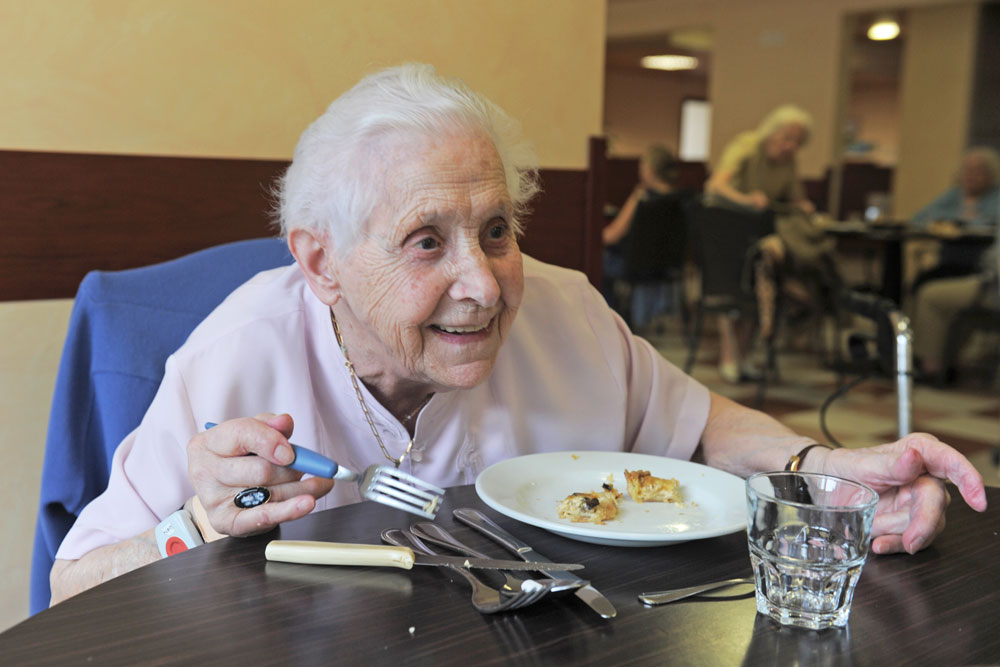Do the residents receive support with a function-enhancing working method?
This article is written based on Swedish conditions. Hopefully it can inspire interested people from other countries.
A function-enhancing working method is used when something has temporarily lost an ability or function. It may be after a hospital stay. A stroke or a fracture can mean that the ability to cope with everyday tasks has deteriorated. Many times it is possible to regain the ability to cope with what you coped with before with the right training and support to exercise in everyday life.
 Foto: Mostphotos
Foto: MostphotosWith a function-enhancing work method or specific rehabilitation, residents can often regain functions they previously lost
All care should be based on a function-preserving working method. This means that the individual is stimulated to manage as much as possible by himself in order to maintain the ability to cope with everyday life. This is often more time-consuming for the staff in the short term, but saves both time and quality of life in the long term. Function-enhancing or rehabilitative work methods also take time in the beginning but save time in the long run.
People who live in nursing homes have often suffered from strokes or other illnesses that limit what they can do. In the aftermath of many diseases, functional impairment follows. Those who have a functional impairment may need help to regain functions or to be helped to learn ways to manage everyday life with or without aids. Rehabilitation takes place partly through everyday rehabilitation, i.e. that the individual himself does as much as possible of the activities in daily life or through function-enhancing interventions prescribed by an occupational therapist or physiotherapist.
ADL assessment a basis for seeing the need for rehabilitation
Physiotherapist and occupational therapist perform an ADL (Activities of Daily Living) assessment upon moving in and design individual training programs. The ADL assessment forms the basis for the extent to which the immigrant needs help and what the immigrant can manage independently. Often it also involves a physiotherapist designing an exercise program or the occupational therapist prescribing aids. Occupational therapists and physiotherapists also supervise other employees so that they work in a way that contributes to rehabilitation. In other cases, this may mean that the municipality helps to adapt the home so that the individual can continue to live.
For the interventions to have the best effect, they should be early, coordinated and versatile. Rehabilitation can take place at home, as day rehabilitation or during a stay in a special unit for this. Where the rehabilitation takes place depends on what the needs and conditions in the home look like.
Through work instructions or delegation, some training can be left to assistant nurses. For example, it can be about regaining the ability to move, personal care, training of mental functions, hand training, standing training, strength training and balance training.
To maximize the quality of life for the residents
Function-enhancing rehabilitation in nursing homes aims to improve the residents' quality of life by maximizing their physical, mental and social functions. It is about working proactively to preserve and increase the residents' functional capacity so that they can continue to live as independent and meaningful a life as possible.
Examples of working methods and measures:
Individual assessment and planning: Each resident's needs and conditions are unique. By carefully assessing each resident's functional level and needs, the staff can create individually tailored rehabilitation plans that focus on maximizing their function and independence.
Physical activity and exercise: Regular physical activity and exercise are essential to maintaining and improving muscle strength, mobility and balance of the residents. By offering different forms of exercise and movement activities, such as walking, balance training and strength training, the staff can contribute to improving the residents' physical function.
Ergonomic adaptations: By making ergonomic adaptations in both the living environment and the activities, the staff can make it easier for the residents to carry out their daily chores and activities. This may include using assistive devices that facilitate mobility and other daily activities.
Cognitive Stimulation: For residents suffering from cognitive impairment, cognitive stimulation can be important in preserving and improving their mental function. It can include activities such as memory training, word games, music therapy and art therapy.
Social interaction: Social interaction and participation in joint activities are crucial for the residents' psychological and emotional well-being. By organizing and promoting social activities and events, the staff can contribute to increasing the residents' enjoyment of life and self-esteem.
Advantages of function-enhancing rehabilitation:
Increased quality of life: By working with function-enhancing rehabilitation, nursing homes can contribute to increasing the residents' independence and enjoyment of life.
Reduced risk of disability: By preventing and treating disabilities early, the staff can reduce the risk of the residents losing their ability to perform everyday activities.
Improved health: Regular physical activity and social interaction can help improve residents' physical and mental health, which can lead to increased longevity and better quality of life.
By actively working with function-enhancing rehabilitation, nursing home staff can make a significant difference in the residents' lives by promoting independence, well-being and quality of life. It is an important part of creating an environment where residents feel safe, respected and appreciated.
Reflection questions - function-enhancing working methods
Care staff:
- Do you receive clear work instructions regarding function-enhancing working methods for your residents?
- Are the tasks delegated?
- Do you have signature lists so that you are reminded to carry out prescribed treatment?
Manager, nurse, occupational therapist and physiotherapist:
- Do you work actively with rehabilitation so that the resident can regain functions that he lost during a previous period of illness?
- How is compliance with prescriptions from occupational therapists and physiotherapists in relation to other prescriptions, for example drug prescriptions?
- If there is a difference, what is the difference due to?
Resident and next of kin:
- Does the staff work so that your loved one maintains functions such as eating or dressing?
- Do they also train to regain functions that have been lost?
Erland Olsson
Specialist nurse
Sofrosyne
Better care every day
Aktuellt i media
- 2024-04-25 04:00 04 Bemötande
- 2024-04-22 04:00 01 Kvalitet
- 2024-04-18 04:00 10 Aktivitet o funktionsbevarande arbetssätt
-
2024-04-15 04:00
09 Mat och måltid
Food and fall prevention. How the nursing home ensures a safe and nutritious food handling.
info Foto: Mostphotos
Foto: Mostphotos - 2024-04-11 04:00 05 Planering
- 2024-04-08 04:00 10 Aktivitet o funktionsbevarande arbetssätt





